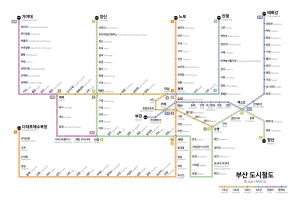
Back بوسان متروسو AZB Metro de Busan Catalan U-Bahn Busan German Metroo de Pusano Esperanto Metro de Busan Spanish Busango metroa Basque متروی بوسان Persian Busanin metro Finnish Métro de Pusan French Puszani metró Hungarian
This article needs additional citations for verification. (July 2014) |
| Busan Metro | |||
|---|---|---|---|
 | |||
 Train on Busan Metro Line 2 | |||
| Overview | |||
| Native name | 부산 도시철도 釜山都市鐵道 Busan dosicheoldo | ||
| Owner | City of Busan | ||
| Locale | Busan, South Korea | ||
| Transit type | Rapid transit, Commuter rail | ||
| Number of lines | 6 | ||
| Number of stations | 114 (metro only) 158 (incl. BGL, Donghae Line) | ||
| Daily ridership | 938,000 (2019, metro only)[1] | ||
| Annual ridership | 343,000,000 (2019, metro only)[1] | ||
| Operation | |||
| Began operation | 19 July 1985 | ||
| Operator(s) | Busan Transportation Corporation B&G Metro Korail | ||
| Technical | |||
| System length | 116.5 km (72.4 mi) (metro only) 205.6 km (127.8 mi) (incl. BGL, Donghae Line) | ||
| Track gauge | 1,435 mm (4 ft 8+1⁄2 in) standard gauge[2] | ||
| |||
| Busan Metro | |
| Hangul | |
|---|---|
| Hanja | |
| Revised Romanization | Busan dosicheoldo |
| McCune–Reischauer | Pusan tosich'ŏlto |

The Busan Metro (Korean: 부산 도시철도; Hanja: 釜山都市鐵道; RR: Busan dosicheoldo) is the urban rail system operated by the Busan Transportation Corporation of Busan, South Korea. The metro network first opened in 1985 with seventeen stations, making Busan the second city in South Korea and third in the Korean Peninsula (after Seoul and Pyongyang) to have a metro system. The Metro itself consists of 4 numbered lines, covering 116.5 kilometres (72.4 mi) of route and serving 114 stations. Including the BGL and the Donghae Line, the network covers 205.6 kilometres (127.8 mi) of route and serving 158 stations.
All directional signs on the Busan Metro are written in both Korean and English, and the voice announcement in the trains indicating the upcoming station, possible line transfer and exiting side are all spoken in Korean, followed by English.transfer station announcements are first Korean, followed by English,then Mandarin, and finally Japanese. Announcements at stations for arriving trains are in Korean, followed by English, then Japanese and Mandarin. All stations are numbered and the first numeral of the number is the same as the line number, e.g. station 123 is on line 1.
The Metro map includes information on which station, and which numbered exit from that station, to use for main attractions. Photography in the Busan Metro is permitted.
- ^ a b "2019년 12월 도시철도 수송실적입니다". Busan Transportation Corporation. January 16, 2020. Retrieved May 20, 2020.
- ^ "B&G Metro - Introduction - Light Rail Vehicles". Archived from the original on 2014-12-08. Retrieved 2014-08-11.
© MMXXIII Rich X Search. We shall prevail. All rights reserved. Rich X Search
